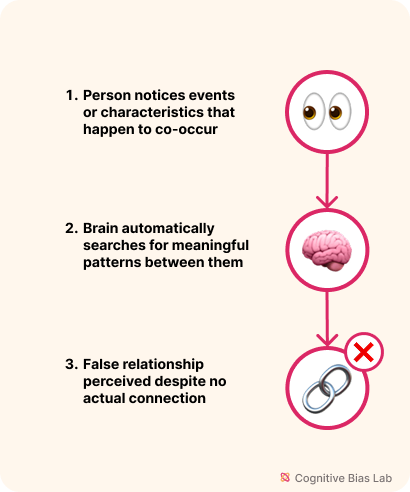Illusory Correlation
Your progress on this bias test won't be saved after you close your browser.
Understanding Illusory Correlation
Illusory Correlation
We instinctively connect unrelated events, creating patterns where none exist. This mental shortcut leads us to see relationships between random occurrences, influencing decisions based on coincidences rather than facts.
What is Illusory Correlation?
Illusory correlation happens when we perceive meaningful relationships between events or variables that are statistically unrelated. Our brains are wired to detect patterns—even where none exist—leading us to form false connections based on coincidental experiences.
Why Does This Happen?
This bias emerges for several key reasons:
- Memorable Events: Unusual or emotionally charged experiences stand out in our memory, making them seem more frequent or connected than they truly are.
- Confirmation Tendency: Once we suspect a relationship, we selectively notice instances that confirm it and overlook those that don't.
- Limited Samples: Drawing conclusions from too few examples can create artificial patterns.
Real-World Impact
- Business Consequences: Companies invest in strategies based on perceived success factors that may actually be coincidental.
- Stereotype Formation: False correlations between group membership and behaviors can lead to unfair prejudices and discriminatory practices.
- Market Analysis Errors: Investors might see patterns in market fluctuations that are merely random variations, leading to poor financial decisions.
Understanding illusory correlation helps us question perceived relationships and demand stronger evidence before assuming causal connections, leading to more rational and effective decision-making.

Visual representation of Illusory Correlation (click to enlarge)
Examples of Illusory Correlation
Here are some real-world examples that demonstrate how this bias affects our thinking:
Marketing Campaign Misconception
A marketing director notices that three successful product launches occurred during rainy days, leading her to believe that launching products during bad weather somehow increases consumer interest. She begins scheduling major releases around weather forecasts, despite the fact that a comprehensive analysis of five years of data would show absolutely no correlation between weather conditions and product performance. This false pattern influences major business decisions based on pure coincidence.
Performance Evaluation Bias
A manager observes that a few employees who wear formal attire tend to deliver presentations more effectively. He develops a belief that professional dress directly impacts performance quality, overlooking the many formally dressed employees with average presentations and casually dressed team members who excel consistently. This illusory correlation leads to unfair evaluations where he unconsciously rates employees in suits higher regardless of actual performance metrics.
How to Overcome Illusory Correlation
Here are strategies to help you recognize and overcome this bias:
Verify with Data
Test patterns using proper statistical analysis instead of trusting anecdotes or surface associations.
Track Perceived Patterns
Keep a journal of predicted correlations and outcomes to see which ones hold up over time and which don’t.
Test Your Understanding
Challenge yourself with these questions to see how well you understand this cognitive bias:
As a product manager, you notice that features launched on Mondays have received better customer feedback three times in a row. What's the most appropriate next step?
Academic References
- Hamilton, D. L., & Gifford, R. K. (1976). Illusory correlation in interpersonal perception: A cognitive basis of stereotypic judgments. Journal of Experimental Social Psychology, 12(4), 392-407.
- Costello, F., & Watts, P. (2019). The rationality of illusory correlation. Psychological Review, 126(3), 437–450.
- Eder, A. B., Fiedler, K., & Hamm-Eder, S. (2011). Illusory correlations revisited: The role of pseudocontingencies and working-memory capacity. Quarterly Journal of Experimental Psychology, 64(3), 517–532.